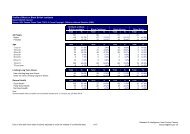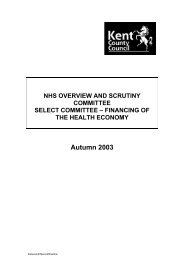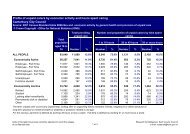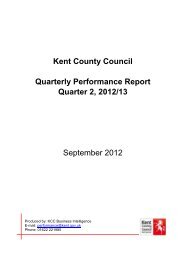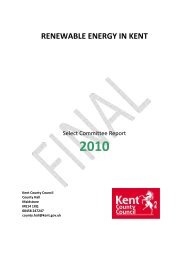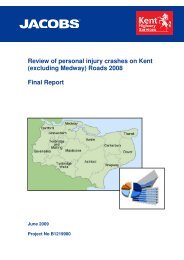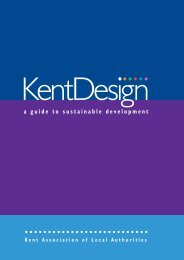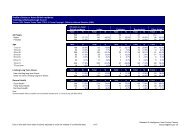Kent Design - Technical Appendix - Kent County Council
Kent Design - Technical Appendix - Kent County Council
Kent Design - Technical Appendix - Kent County Council
Create successful ePaper yourself
Turn your PDF publications into a flip-book with our unique Google optimized e-Paper software.
process<br />
The Final Certificate will only be issued when:<br />
• The transfer of the ‘highway’ land has been completed -<br />
that is, the area of land colour-washed pink on the<br />
approved Section 38 drawings.<br />
• All necessary Deeds of Grant for drainage or street lighting<br />
situated outside the highway limits have been completed.<br />
• Landscaping areas that are to be adopted are fully<br />
established and planted in accordance with the<br />
specification. If the Developer defaults on the maintenance<br />
aspect and there is a need to re-plant, adoption will be<br />
delayed until the landscaping is fully established or<br />
alternatively the developer pays a commuted sum to the<br />
Highway Authority so that adequate maintenance can be<br />
given in the early years. If more than 20% of planting has<br />
to be replaced before final adoption, then the developer<br />
will be required to extend his liability for maintenance for<br />
a further period to be agreed with the Area Manager.<br />
• A Health and Safety File, as required by the<br />
Construction (<strong>Design</strong> and Management)<br />
Regulations 1994, has been delivered to the Area<br />
Manager. The H&S File should include two sets of ‘as<br />
constructed’ drawings and appropriate data for Highway<br />
Inventory and Structures Database input.<br />
• All other requirements of the Section 38 Agreement have<br />
been fully complied with.<br />
The Agreement will provide for the payment to the Highway<br />
Authority of costs associated with the works and these will be<br />
detailed in the Agreement. Additional commuted sums will be<br />
necessary for the future maintenance of adopted highway structures.<br />
The Agreement will contain a clause stating that no dwelling shall be<br />
occupied until all works specified in Part I of the schedule to the<br />
Agreement up to and including the frontage of the property in<br />
question and connecting it to a highway maintainable at public<br />
expense have been completed and approved. In some circumstances,<br />
the connecting road may itself be subject to a Section 38 Agreement.<br />
1.3 A SUSTAINABLE APPROACH TO HIGHWAYS<br />
CONSTRUCTION<br />
1.3.1 INTRODUCTION<br />
Developers should be aware that the Highway Authority is<br />
committed to the implementation of sustainable solutions wherever<br />
it is possible to include them economically and viably, without<br />
compromising unduly the quality of the finished works.<br />
The standards for the pavement thicknesses and the choice of<br />
materials detailed in <strong>Kent</strong> <strong>Design</strong> are indicative of the minimum<br />
standards that will be acceptable to the Highway Authority.<br />
Developers should demonstrate their commitment towards<br />
sustainability by considering alternative construction materials, which<br />
satisfy the principles of sustainability shown below, but retain similar<br />
performances to those of more traditional materials. Each site will<br />
have its own individual characteristics which will need to be evaluated<br />
accordingly. Evidence of this evaluation should be provided.<br />
Techniques to conserve resources and the use of recycled materials<br />
are developing rapidly as they become more competitive.<br />
Consequently more and more public authorities are demanding that<br />
sustainability issues are addressed positively and constructively.<br />
<strong>Kent</strong> <strong>County</strong> <strong>Council</strong> now has a committed approach to sustainable<br />
solutions and can provide an approval process that includes a<br />
technical assessment of the re-used or recycled product and the<br />
method of recycling, together with laboratory appraisals and field<br />
trials where necessary.<br />
18<br />
<strong>Kent</strong><br />
<strong>Design</strong><br />
The approval process and any relevant specification required will<br />
only be provided at the developer’s expense. Specifications can be<br />
produced where required for specific development needs and<br />
contract control purposes<br />
There are a number of <strong>Kent</strong> specific clauses denoted by the suffix AK.<br />
These are additional to those within Volume 1 of the Highways<br />
Agency’s Manual of Control Documents for the Highway Works, and<br />
can be obtained from <strong>Kent</strong> <strong>County</strong> <strong>Council</strong>.<br />
1.3.1.1 PRINCIPLES OF SUSTAINABILITY<br />
Sustainability is concerned with conservation of resources. In<br />
engineering terms this could be achieved in the following ways:-<br />
• Minimising of Materials.<br />
• Reduction of Waste.<br />
• Recovery of Materials for re-use.<br />
• Re-use and Recycling of Materials.<br />
TABLE 1: PRINCIPLES OF SUSTAINABILITY<br />
Minimising of Materials Use only the minimum materials necessary<br />
for the development and, where practicable,<br />
the thinnest pavement design of the<br />
available permitted options. (see notes a)<br />
Reduction of Waste Developers can effectively reduce the<br />
wastage of materials by introducing regular<br />
audits to monitor and control site activity<br />
more closely, e.g. materials ordering and site<br />
practices. (see clause 1.3.3)<br />
Recovery of Materials Where any site clearance or demolition is<br />
for Re-Use<br />
involved, the developer should initially<br />
maximise the recovery and re-use of any<br />
materials within the confines of the site or<br />
alternatively off-site. (see note d)<br />
Re-Use and Recycling Acceptable methods of recycling include:-<br />
of Materials<br />
cold processing on or off-site and hot<br />
processing off-site. (see notes e - i)<br />
Notes on Table 1<br />
(a) <strong>Kent</strong> Pavement <strong>Design</strong> Guide includes ‘Asphalt Substitution’ which may be used<br />
to reduce the sub-base thickness.<br />
(b) <strong>Kent</strong> <strong>County</strong> <strong>Council</strong>’s Standard Specification which augments the Specification<br />
contains additional or revised clauses to assist contractors to implement sustainable<br />
alternatives as described in Para 1.3.6.<br />
(c) Pozzolanic (hydraulic bound) materials e.g. Phosphoric Slag in accordance with<br />
Clause 886 AK, consist of re-used industrial waste products or incorporate binders<br />
such as slag or Pulverised Fuel Ash (PFA) which are industrial waste products. Benefits<br />
resulting from their use include the reduction of the total quantities of materials<br />
needed on site and savings on transportation costs.<br />
(d) Acceptable materials for re-use include kerbs, channels, gully grates and pots,<br />
manhole and inspection covers, which are of equivalent specification, in good order<br />
and appropriate for the location. Other street furniture may also be considered<br />
acceptable by the Engineer.<br />
(e) In-situ processing techniques are considered more environmentally friendly. They<br />
can also increase operational speeds on site, reduce local traffic congestion and<br />
transportation costs. Services to carry this out are widely available from specialist<br />
contractors. Consideration shall be given for the potential effects of noise and dust<br />
produced by the processes.<br />
(f) Cold processing on site, in accordance with Clauses 614, 615 and 994 AK may be<br />
used to improve the road foundation and reduce or even eliminate the need for<br />
imported granular material.<br />
(g) Cold processing on site methods, in accordance with Clause 994 AK and Clause<br />
1086 AK, can be carried out on existing materials or on demolition materials, planings<br />
or other imported materials to produce structural pavement layers. They can be used<br />
in a wide range of carriageway and footway locations.<br />
(h) Cold processing off-site produces materials which, when combined with bitumen,<br />
bitumen emulsion and other binders, can be used as road base layers on most<br />
residential access roads and distributor roads, in accordance with Clause 996 AK.<br />
(i) Hot processing off-site, in accordance with Clause 902 or a modified clause subject<br />
to the Engineer’s approval, produces new bitumen bound materials which can be used<br />
in place of materials with no recycled materials content.






